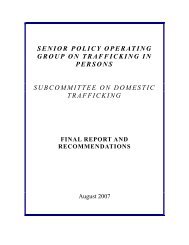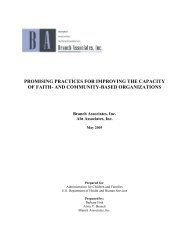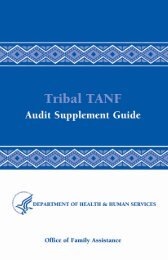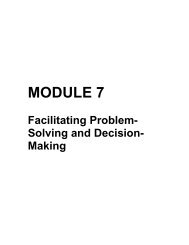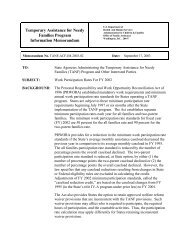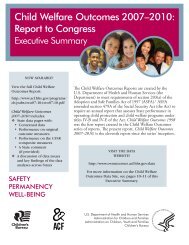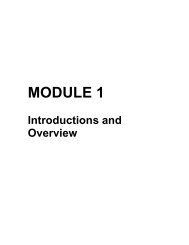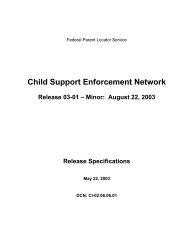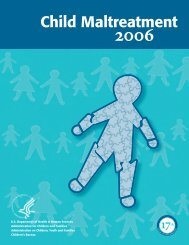AFCARS Assessment Review Report - Administration for Children ...
AFCARS Assessment Review Report - Administration for Children ...
AFCARS Assessment Review Report - Administration for Children ...
Create successful ePaper yourself
Turn your PDF publications into a flip-book with our unique Google optimized e-Paper software.
The State will also have to modify the collection of this in<strong>for</strong>mation to meet the new NationalYouth in Transition Database (NYTD) race requirements. Guidance on these options and how tomap them <strong>for</strong> <strong>AFCARS</strong> purposes is provided in the attached matrices.Child’s Diagnosed ConditionsThis also is an area with a significant amount of missing data; 40% of the records in the 2008Areport were missing in<strong>for</strong>mation. For <strong>AFCARS</strong> reporting purposes, the in<strong>for</strong>mation reported <strong>for</strong>these elements reflects chronic and/or significant diagnosed conditions that the child may have.CHESSIE contains several screens that include in<strong>for</strong>mation pertaining to these elements (see theFindings document <strong>for</strong> more in<strong>for</strong>mation). One area is a health section that contains severalitems related to these elements. Caseworkers are supposed to complete each screen/field.Consequently, this results in duplicative data entry, which results in issues related to dataaccuracy and SACWIS compliance. The State needs to make modifications to consolidate allthis in<strong>for</strong>mation into one section of the system and make the corrections as noted above.Additionally, this correction will address the issue of data duplication raised by the <strong>Children</strong>’sBureau <strong>for</strong> SACWIS compliance. A resource list of conditions to be mapped to <strong>AFCARS</strong> islisted on the <strong>Children</strong>’s Bureau’s web page athttp://www.acf.hhs.gov/programs/cb/systems/afcars/resourcesIn addition, the system does not contain the question “has this child been diagnosed with adisability?” The <strong>AFCARS</strong> responses to this question have specific definitions. These are:“Yes” indicates that a qualified professional has clinically diagnosed thechild as having at least one of the disabilities listed below.“No” indicates that a qualified professional has conducted a clinicalassessment of the child and has determined that the child has no disabilities.“Not Yet Determined” indicates that a clinical assessment of the child by aqualified professional has not been conducted.Another significant issue with the State methodology <strong>for</strong> collecting these data is that there are nodates associated with the child’s diagnosed conditions. Consequently, a complete history is notmaintained to reflect the time frame the child may have each condition. This is especiallyproblematic <strong>for</strong> files that the State resubmits.Removal EpisodesFor <strong>AFCARS</strong> purposes, a removal episode is the period of time in which the State has care andplacement responsibility <strong>for</strong> a child. In <strong>AFCARS</strong> this is the time between the child’s “Date ofLatest Removal” (foster care element #21) and the child’s “Date of Most Recent Discharge”(foster care element #56). A child may have more than one episode if he or she was removedfrom home more than once. This is not to be confused with the number of placement settingsthat a child has experienced. Within one removal episode, a child may have multiple placementsettings.US DHHS/ACF/ACYF/<strong>Children</strong>’s Bureau 7





